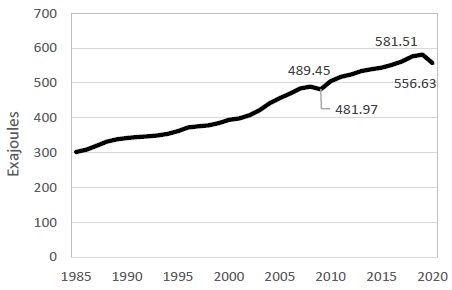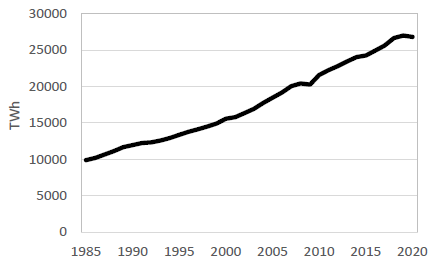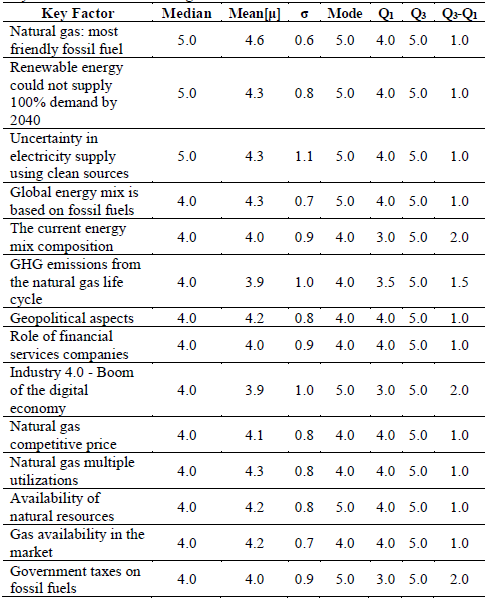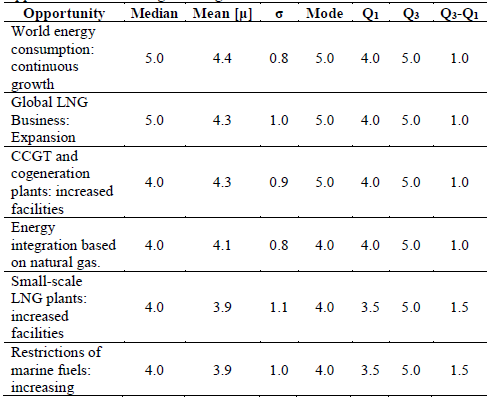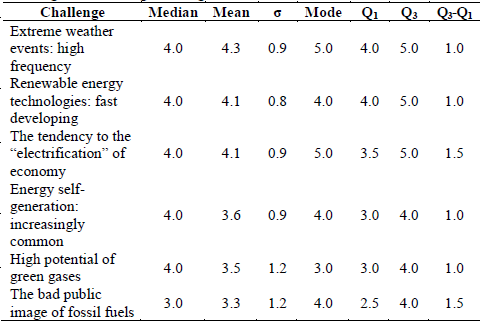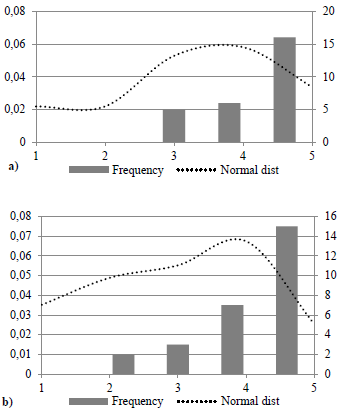1 Introduction
The 2030 Agenda for Sustainable Development, adopted by the United Nations (UN) in September 2015, frames the 17 Sustainable Development Goals (SDG) that range from ending poverty to establishing global alliances [1]. Among these objectives, the SDG 7 proposes, "Ensure access to affordable, reliable, sustainable, and modern energy for all". Additionally, the SDG 7 sets several targets by 2030: increase share of renewables; improve the global rate of energy efficiency; enhance international cooperation to facilitate access to clean energy research and technology; and expand infrastructure and upgrade technology for supplying modern and sustainable energy services for all in developing countries [1]. KPIs related with these targets are reported annually by an assistance program supported by several custodian agencies in a specific website [2].
For the 2030 Agenda, the sustainable development implies that the world must meet its current needs without compromising the ability of future generations to meet their own needs [3].
Climate change and the climate crisis are consequences of human actions. The energy sector-responsible for almost 75 % of global greenhouse gas (GHG) emissions-is the main factor in this situation [4]. Current trend indicates energy consumption will continue to grow over the next 30 years.
The fight against climate change looks thorny and complex. Share of carbon-emitting energy sources-oil, coal, and natural gas-in the global energy mix needs to be significantly reduced. Currently, fossil fuels represent more than 80 % of world energy consumption [4,5] and the needs raised by different organizations (e.g., UN, IEA, BP) to mitigate climate change place this quota for the year 2050 from 22 % to 40 %, depending on courses of action [6]. Much effort is needed to reduce carbon dioxide (CO2) and methane (CH4) emissions, nitrates (NOx), sulphur dioxide (SO2), and particulates in the air and meet the fundamental targets of the Paris Agreement at COP 21 (adopted by 196 parties) [7]. If the current trend of fossil fuels consumption continues, the world will not be able to mitigate the effects of climate change on the people [8].
Global economy is becoming progressively electrified [9], including electric vehicles, which will increase demand for electric power [10]. Some experts [11,12] or organizations [13] point out that, in order to meet the UN goals, total demand for electricity must be satisfied using clean sources (i.e., renewable energy). However, other experts believe it is not possible to meet the increased demand for electricity using only renewable sources [14,15].
Energy transition to cleaner energy sources issue is recurring in many forums, platforms or manifesto commitments, conferences, and conventions. World society demands this transition once the effects and consequences of climate change have been seen. As it is the cleanest among fossil fuels [16], natural gas could play a key role in this energy transition process [14]. However, there are at least three points-of-view about the natural gas role: 1) fuel "bridge" to a new energy world composed mainly of renewable clean technologies; 2) barrier to development of new technologies because its flexibility and availability; 3) continuation of our economy's dependence on fossil fuels (i.e., destination fuel) [17,18].
In this paper, a study on the future of natural gas in the current global energy transition is presented. This work analyzes the opinions of experts on energy and environmental issues to establish what the role of natural gas in world energy mix would be over the period of 2021 to 2040. In Section 2, the International Energy Agency (IEA) scenarios, and the figures for primary energy sources and electricity generation are presented as background. Methodology and tools used are presented in Section 3. The results are discussed in Section 4, and Conclusions are drawn in Section 5.
2 Background
2.1 World Energy Outlook (WEO) 2021 - IEA
In October 2021, the International Energy Agency (IEA) presented four scenarios of future energy trends in its Global Energy Outlook report [4]:
Stated Policies Scenario (STEPS). Current policy settings based on a sector-by-sector assessment of the specific policies in place, as well as those announced by governments around the world.
Announced Pledges Scenario (APS). All climate commitments made by governments around the world, including Nationally Determined Contributions (NDCs) and longer-term net zero targets, will be met in full and on time.
Net Zero Emissions by 2050 Scenario (NZE). A narrow but achievable pathway for the global energy sector to achieve net zero CO2 emissions by 2050.
Sustainable Development Scenario (SDS). A pathway aiming at achieving the SDGs adopted by the UN, limiting the increase in world temperature well below 2°C (35.6 °F) compared with pre-industrial levels to significantly reduce air pollution and ensure universal access to energy services, and taking effective action to combat climate change.
World total energy supply would increase 26 % by 2050 compared to 2020 in the STEPS, and 14 % for the APS. The pathways for the NZE and the SDS require a decrease in the global energy supply of 8 % and 2 %, respectively, to achieve their goals.
The STEPS is the only scenario that reflects an increase in the supply of fossil fuels in the long term (5 % by 2050). However, fossil fuels share would drop to 66 % of total primary energy. All other scenarios require a decrease in the use of fossil fuels. The proportion of fossil fuels would decrease to 53 % APS, 36 % SDS, and 22 % NZE scenarios by 2050 [4].
Natural gas demand would grow 28 % (14 billion cubic meters per day (bcmd) on average) compared to 2020 demand (11 bcmd) for the STEPS. These figures would be led by China, India, and countries in Southeast Asia and Africa. Gas demand in the US and European countries would decline by 2050 [4]. Natural gas production would decrease in all other scenarios, 4 % APS, 39 % SDS, and 56 % NZE.
In conclusion, the IEA-in its more environmentally responsible energy systems scenarios-reflects the need to reduce fossil fuels consumption, including natural gas, to achieve the goals necessary to mitigate climate change effects. However, difficulties of many countries to follow the courses of action towards the reduction of announced emissions (APS) or to effectively achieve sustainability (NDS) or net zero emissions (NZE) are evident. The STEPS premise that drastic changes in policy orientation in favor of a more sustainable recovery are unlikely may be dominant worldwide by 2050.
2.2 Worldwide Energy Statistics
Primary energy consumption worldwide has grown steadily (see Fig. 1), except for three periods: 1980-1982 (-0.6 % annual average), 2009 (-1.5 %), and 2020 (-4.3 %), because of global recession episodes set off by a drop in oil production in the wake of the Iranian Revolution, the global financial crisis caused by the housing market bubble, and the deepest economic recession in nearly a century triggered by the COVID-19 pandemic, respectively [19,20]. Despite the crisis episodes over the period of 1965 to 2020, the annual growth in primary energy consumption averaged 2.4 %.
The global energy mix has been based on fossil fuels. From 1965 to 2000, approximately 90 % of energy consumption came from fossil sources, while from 2001 to 2020 fossil fuels had 86 % on average. In 2020, the share of fossil fuels was 83 %, while new renewable energies and hydroelectricity obtained almost 13 % (see Fig. 2). The reduction in mobility on a global scale and changes in work habits (teleworking) due to COVID-19 are some of the reasons for these 2020 figures. The IEA's projections indicate global energy demand in 2021 would exceed pre-COVID-19 levels [21], showing that structural changes needed in the energy market need to be deeper to curb energy consumption.
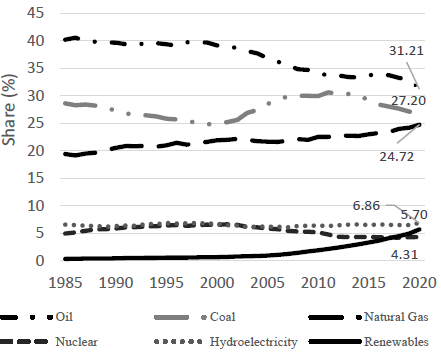
Source: Own elaboration based on data from BP [5].
Figure 2 Worldwide 1985-2020 energy consumption distribution by type of fuel.
Advance of renewable energies-including hydroelectric-in the global energy mix stands out. During the last 5 years, clean sources had a year-on-year growth rate of 13.4 %. In the same period, natural gas increased an average of 1.9 % annually, while oil decreased 1.0 % and coal 0.9 %, (see Fig. 2). Natural gas is being a real alternative to complement renewable sources in a future decarbonized energy system.
Separate chapter deserves nuclear energy, a non-renewable source that does not emit CO2, whose consumption after the accident at the Fukushima nuclear power plant in 2011 in Japan fell by 2 % per year until 2015, and thereafter had a 0.5 % annual consumption growth. Nuclear sources are seen as ideal to operate as a base load in electrical systems that increasingly incorporate variable sources of renewable energy, such as wind and PV, to reduce carbon emissions. However, doubts about its operational safety-accidents and nuclear waste management, which have caused closure of plants and phased-out of other plants-mean nuclear energy has not been considered a valid alternative for a decarbonized energy future.
2.3 Power generation
Global electricity generation has grown continuously since 1985, except during the same years of decline in primary energy consumption: 2009 (-0.8 %) and 2020 (-0.7 %), although with less significant drops (see Fig. 3). Despite crisis episodes, over the period of 1985-2020, the annual growth of electricity generation averaged 2.91 %, 1.64 times the slope of primary energy consumption. The electrification of the global energy system is gaining relevance.
Coal has been the energy source most used for electricity generation during the last 35 years (see Fig. 4). In 2020, coal was used to generate 35 % of the world's electricity. The reason for these figures for fossil fuel with higher emissions is its low cost, which allows lower-income countries to access the energy at an affordable. However, coal has decreased an average of 3.2 % annual during 2019 and 2020.
Also, natural gas has increased its share significantly on the electric mix, surpassing nuclear and hydroelectric generation at the beginning of the 21st century (see Fig. 4). The limitations these energy sources have and recognition that natural gas can be a transition fuel towards cleaner energies could have caused this. However, it should be noted that the growth rates of coal and natural gas have been similar.
As shown in Fig. 4, in 2020 natural gas had a 23 % share, 16 % hydroelectric, 12 % renewables, and 10 % nuclear.
Then, one of the key drivers of the global growth of natural gas consumption has been power generation. The installation of new combined-cycle plants with gas turbines to meet the growing demand for electricity and the conversion of old thermal plants that operated with coal and heavy fuel oil to adapt them to current energy policies have enabled this growth.
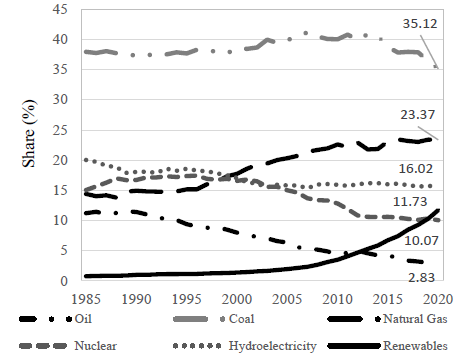
Source: Own elaboration based on data from BP [5]
Figure 4 Electricity generation by type of source.
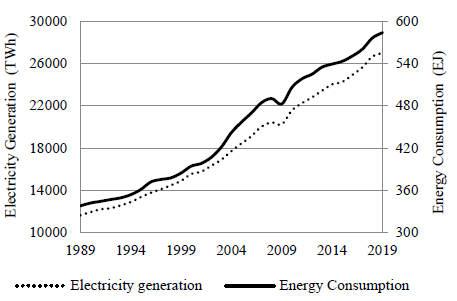
Source: Own elaboration based on data from BP [5]
Figure 5 Electricity generation and energy consumption: trends
As shown in Fig. 5, in the last decade, the growth rate of electricity generation (2.7 %) has been greater than the growth rate of world energy consumption (1.6 %). Because of climate policies, the world economy is electrifying. As mentioned before, this electrification will create a new demand for electric power generation.
3 Methodology
This paper evaluates the relevance of the variables and selects those that will impact the world energy market due to the current climate change crisis. As there are multiple variables, expert knowledge on energy and environmental issues, and their practical application, is necessary to discuss and agree on the role of natural gas in the global energy mix. This need for experts justifies the choice of the Delphi method, even though careful design and planning is required to successfully apply it.
Delphi-considered a qualitative methodology, consists of a general prospective method based on expert consultation and widely applied in social sciences [22]. Several studies have recently been published reporting the use of the Delphi technique in: renewable energy assessment [23], scenario analysis for renewable energy planning [24], wave energy classification for planning aims [25], and how to manage the differences in expectations, and preferences for energy systems planning [26].
This method can be used for factual and value judgments, which are very useful for predicting complex behavior problems. In knowledge areas where exact information is not available or is controversial, group experience is good for obtaining a first prognosis.
All this makes the Delphi method an ideal technique for evaluating the role of natural gas in this whirlwind of ideas and projects on climate change and energy transition, and, therefore, very useful in an exploratory study such as the one presented here [22].
3.1 Experts group composition
Universe of possible participants is closely related to objectives of the study. Experts from academia, professionals from the hydrocarbon industry and civil servant professionals were selected. In short, people who can provide relevant inputs. They are specialists in climate change, environmental management, natural gas, renewable energies, or electrical systems.
In general, the Delphi method does not require the determination of a representative sample for statistically significant results. However, several studies have considered that a sample size of 7-30 participants would be appropriate. Fewer participants are not considered a representative sample, and a larger sample size may generate some inconveniences derived from the longer time involved in carrying out the study [22].
Nevertheless, to invite as many experts as possible within the possibilities and scope of the study due to the use of telematic surveys was proposed for this work.
Before sending them a questionnaire, several experts were contacted by email requesting for their acceptance as members of the panel. Forty-nine of them agreed to participate. Criteria considered for choosing experts were based on relevance of their work in the field of study, their reputation and position within representative organizations about this work.
A total of 27 experts answered the submitted forms. The level of response among academics was 12 questionnaires out of 22 (55 %) and 15 out of 27 professionals completed the questionnaire (56 %). The group included experts working in different countries, Spain, Saudi Arabia, Qatar, the US, Canada, Colombia, and Venezuela. In short, the number of experts who have responded (27) was considered sufficient and statistically significant [22].
3.2 Survey questionnaire
The questionnaire aimed to collect qualitative opinions of participants by means of quantitative criteria. Identification of key drivers, opportunities and challenges of natural gas in the energy transition process were selected as variables to study.
First of all, a brainstorming process with a group of three expert researchers was carried out. They wrote explanatory survey questions and comments to contextualize each question. Once consensus on which questions were relevant was reached, a survey questionnaire using the Google Forms application was developed.
The survey questionnaire considered a graded intensity scale (1 - Unimportant and 5 - Extraordinary importance), with the intermediates used by the Likert scale. The form was validated in a pretest which was sent to a selective sample of experts composed of three academics and two professionals. These experts introduced some modifications to the initial questionnaire. The aspects considered would shed some light on the role of natural gas during the energy transition process, by identifying main drivers, its positive aspects (opportunities), and its negative aspects (challenges).
3.3 Statistical process
The study has been carried out in several phases. The first phase begins with sending of the first survey questionnaire to experts and later collection and processing of the completed surveys. Then, different statistical measures of data processing were obtained-the mean, the median, and the mode. The authors developed tools based on Microsoft Excel® to process all data.
According to the Delphi literature, there is no single way to estimate expert consensus. However, among the different possibilities, in this work the most used measures in practice were applied [27]. The measure that best represents group opinion is the median [m]-above the mean or the mode-for expressing the central tendency of the response. From the two semi-series located on both sides of the median, two quartiles that allow assessing the dispersion are obtained: the first quartile [Q1] as a median of the first semi-series and the third quartile [Q3] as a median of the second semi-series. The difference, third quartile minus first quartile [Q3 - Q1], is known as Interquartile Range [IQR], and is intended to measure dispersion of the sample, being inversely proportional to group consensus (i.e., higher rank lower consensus). The arithmetic mean [µ] characterizes central tendency and the standard deviation [o] measures dispersion.
Finally, during the last phase (i.e., results analysis) all answers of experts were considered equivalent, that is, they were not differentiated or weighted according to their knowledge level of topics. As future work, antecedents of each professional will be discretized to determine the bias in their answers.
3.4 Variables
Three sets of variables that could affect or potentially affect the role of natural gas in the process of transition to a new energy mix have been identified. Sets are key drivers (14 variables), opportunities that would be presented to natural gas (6 variables) and challenges visualized for natural gas having an important role (6 variables). The results of the study are detailed below, analyzing each group of questions made or variables evaluated, following questionnaire structure.
3.4.1. Key Factors
The variables identified as key factors were:
a) Natural gas: most environmentally friendly fossil fuel. Natural gas is considered the most environmentally friendly fossil fuel. Natural gas-fired power generation produces approximately 45 % less CO2 emissions than coal, and 30 % less than oil [16].
b) Renewable energies could not supply 100 % demand by 2040. The IEA's scenarios reflect that it is not possible to replace the entire current energy system-based on fossil fuels-to clean sources in 20 years [8].
c) Uncertainty in electricity supply using clean sources. The energy production from renewable sources is variable in time; therefore, a supply of available baseload is required to provide robustness to the electrical system, which can be facilitated by natural gas or other fossil fuels [14,17].
d) Global energy mix is based on fossil fuels. The current global energy mix is based on fossil fuels. From 1968 to 2008, approximately 90 % of energy consumption has been from fossil sources, while over the period of 2008 to 2020 the fossil fuels mix was 86 % (see Figs. 1 - 2) [5].
e) Energy mix composition. The composition of energy mix of each country or region is important. If this mix is based on coal or crude, gas would have a prominent role. If not, renewable sources will be widely used [28].
f) GHG emissions from the natural gas life cycle. Greenhouse Gas (GHG) emissions during the natural gas life cycle may be higher than other fuels. If the life cycle of natural gas is considered, it would be accounted for: 1) CH4 emissions due to leaks, pipeline failures, and operational venting, and 2) CO2 emissions associated with the methane burn for lacking handling capacity of production facilities. CH4 has a greenhouse effect at least 25 times more potent than CO2 [29].
g) Geopolitical aspects. Important conventional natural gas reserves are in areas of political conflicts. Iran, Qatar, Iraq, and other Middle East countries have nearly 40 % of world reserves. Russia with 20 % of world reserves [5] uses gas diplomacy.
h) Role of financial services companies. Availability of funding resources for fossil fuel exploitation projects is reduced due to being considered dirty energy sources.
i) Industry 4.0 - Boom of the digital economy. This variable includes Big Data, Artificial Intelligence (AI), Internet of Things (IoT), and Industrial Internet of Things (IIoT). Monitoring of energy systems will improve efficiency, productivity and quality of energy producers, and energy end-users.
j) Natural gas competitive price. Competitive price of gas compared to oil, coal, and other sources.
k) Multiple uses of natural gas. Natural gas is an important raw material for the petrochemical and industrial sectors. In addition, natural gas can be used in vehicles as a fuel.
l) Availability of natural resources. The availability of natural resources and technology for their exploitation is pivotal. Existence of fossil energy sources in countries drives to their use.
m) Market availability of gas. An oversupply of gas in the market should guarantee its availability and not very high prices. But the opposite is also true, as it happened in 2021.
n) Government taxes on fossil fuels. Governments can apply higher taxes on oil and coal consumption, favoring natural gas and renewable sources. However, a tax on natural gas consumption could be applied.
3.4.2. Opportunities
Following, opportunities evaluated are presented.
a) World energy consumption: continuous growth. The sustained growth of world energy consumption is a fact (see Fig. 5). The annual growth of energy consumption during the last 50 years was on average 2.5 %. This trend is expected to endure for 20 additional years (see Fig. 1).
b) Global LNG Business: expansion. Increase in the commercialization of liquefied natural gas worldwide is huge. LNG is the easiest way to buy natural gas without being connected to a network of gas pipelines.
c) CCGT and cogeneration plants: increased facilities. Increase in the installation of combined cycle gas and cogeneration plants. These systems represent a more efficient way to power generation.
d) Energy integration based on natural gas. Energy integration based on natural gas can improve the electricity sector. It seeks to provide robustness of power supply.
e) Small-scale LNG plants: increasedfacilities. Monetization of small and stranded natural gas reserves through LNG-for local uses and access to remote areas-is highly feasible.
f) Restrictions of marine fuels: increasing. According to the International Maritime Organization (IMO), emissions of sulfur oxides (SOx) caused by use of the fuel oil should be reduced to less than 0.5 % w/w. LNG is being used as an alternative fuel, with an estimated growing and significant demand.
3.4.3. Challenges
g) Following, the challenges that can define the role of gas in the future are presented.
h) Extreme weather events: high frequency. The acceleration of global warming and a high occurrence of extreme weather events are facts. Global warming has increased by 25 % in just three years (2014-2016) [2]. It coincides with extreme weather events-heat waves, droughts, floods, extensive melting of polar ice, and global coral discoloration.
i) Renewable energy technologies: fast developing. The high technological development of renewable energy sources highlights. A significant decrease in investment costs (CAPEX) has occurred, generating or increasing the profitability of projects from some sources such as wind and solar.
j) The tendency to the "electrification" of economy. The electrifying of the energy sector can decarbonize the economy. Development of electric vehicles and intensive use of electric household appliances are in that direction [30].
k) Energy self-generation: increasingly common. The growth of electric self-generation and the use of heat pumps are highlighters. Technological mastery of renewable sources makes its installation in domestic environments more feasible, which in combination with a heat pump system would lower the external energy consumption of households.
l) High potential of green gases. Studies suggest that potential of hydrogen from renewable sources and other "green" gases can play a key role in a clean, safe, and affordable energy future.
m) The bad public image of fossil fuels. The growing public animosity against the use of fossil fuels should worry companies whose future depends on natural gas. "All fossil fuels must be eliminated from the energy mix to favor the use of clean energy sources" is a widely used phrase that damages position of natural gas in the energy market.
4 Results
The results of the study are detailed below. Each group of variables is analyzed, following the structure of the survey questionnaire: 1) key factors; 2) opportunities; and 3) Challenges.
4.1 Key factors
Among the instruments presented to the experts as necessary to determine the role of natural gas in this stage of energy transition (see Table 1), three major key factors highlight: a) natural gas: most environmentally friendly fossil fuel; b) renewable energy could not supply 100 % electricity demand by 2040, and c) uncertainty in electricity supply using clean sources. These factors obtained a Median of 5.0 (maximum valuation of Likert scale.) The degree of consensus among experts is acceptable because the IQR = 1.
The messages that can be obtained from these results are:
a) Replacing current fossil energy sources-coal and natural gas in the energy sector, oil in the transport sector-in the next 20 years with clean renewable energy would represent a great challenge that seems difficult to achieve.
b) The variability of wind and solar energy production causes uncertainty in the energy market. This problem has been active for many years, but significant technological and economic obstacles to storing surplus green energy still are present. Storage batteries and the production of hydrogen or ammonia as energy vectors are technological solutions considered the most realistic to solve this variability. However, the profitability or sustainability of these storage technologies are big questions today.
Natural gas-the cleanest fossil primary energy source and simpler replacement of coal and oil on their main uses-would be the best solution. In this way, more gas-fueled power generation capacity could be installed, convert coal power plants to natural gas and replace oil in the transport sector using natural gas, LNG and products of Gas-to-Liquids plants, allowing an orderly transition to greater use of clean energies. This way, a better relationship between environmental costs and people's access to affordable energy would be reached.
Natural gas as the cleanest fossil fuel obtained the highest arithmetical mean (4.6) and the lowest standard deviation (0.6). This shows that to the experts this variable is the key factor in the role of natural gas for sustainable development. The other eleven key factors obtained a Median of 4.0, which placed them in a second level of importance. The degree of consensus in seven factors was acceptable. Consensus for factors-the current energy mix composition, GHG emissions from the natural gas life cycle, Industry 4.0 - Boom of the digital economy, and Government taxes on fossil fuels-was non-acceptable, because the IQR > 1 (see Table 1).
Fig. 6 shows the frequency distribution and the normal distribution of the three major key factors resultant of the study. The statistical values obtained are representative of all the variables considered.
The factors "World energy consumption: continuous growth" and "Global LNG Business: expansion" represent big opportunities for natural gas to play an important role in this energy transition. The sustained growth in world energy consumption expected for at least 15 years will allow natural gas to increase its supply volume, despite its share in the world energy matrix may decrease. In addition, natural gas will be the least affected fossil fuel in a deep transition scenario (SDS or NZE) towards renewable energies and take a large percentage of coal's share in power generation.
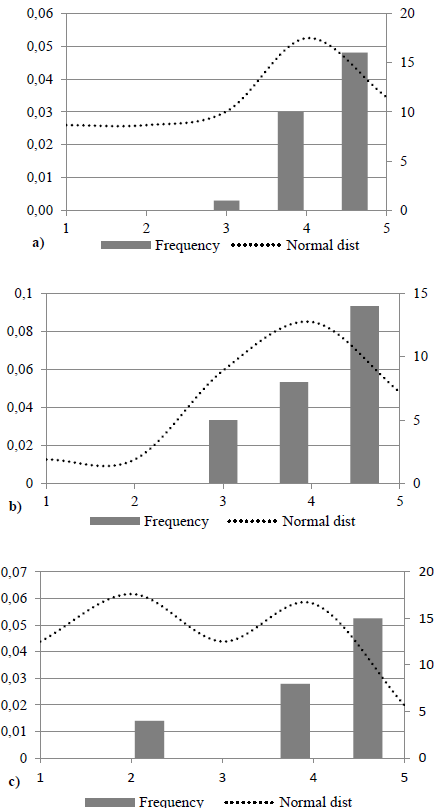
Source: Own elaboration
Figure 6 Histograms of the three major key factors: a) natural gas: most environmentally friendly fossil fuel, b) renewable energy could not supply 100 % demand by 2040, and c) uncertainty in electricity supply using clean sources.
Factor "World energy consumption: continuous growth" obtained the second highest Mean value (4.4) of all variables and a standard deviation of 0.8. The other six opportunities, which obtained a Median value of 4.0, are in second level of importance. The consensus was acceptable in two factors: 1) CCGT and cogeneration plants: increased facilities, and 2) energy integration based on natural gas (IQR=1.0). The consensus for the following factors-Small-scale LNG plants: increased facilities, and restrictions of marine fuels: increasing-was non-acceptable because the interquartile range (Q3-Q1) was 1.5 (see Table 2).
Fig. 7 shows frequency distribution of the two major opportunities, as well as its normal distribution. Results indicate statistical values obtained are representative for variables studied.
4.2 Challenges
Among the instruments used to determine challenges energy transition presents to natural gas (see Table 3), no factor obtained a Median of 5.0, meaning none was viewed as a big challenge. All factors except "Bad public image of fossil fuels" obtained a Median of 4.0.
The degree of consensus was acceptable for four challenges, and two variables did not obtain consensus: a) tendency to the electrification of the economy, and b) bad public image of fossil fuels.
5 Conclusions
The role of natural gas in this developing energy transition process is determined by analyzing key factors, opportunities, and challenges related to the global energy industry. A Delphi study was developed to determine relevance of variables associated to these three factors. This study included a 26-question survey questionnaire taken by 27 experts from academia, the hydrocarbon industry, and government institutions.
Results show three major key factors will rule the role of natural gas in the energy transition: a) natural gas: most environmentally friendly fossil fuel; b) renewable energy could not supply 100 % demand by 2040, and c) uncertainty in electricity supply using clean sources. Two opportunities are seen as the most significant: a) world energy consumption: continuous growth, and b) global LNG business: expansion. Meanwhile, no major challenge will face natural gas during the energy transition period, although five of the six challenges are considered relevant challenges. All the major factors had the consensus of experts.
One of the main tasks facing governments is to provide affordable energy to people while limiting the effects of global warming on weather and climate. Natural gas-as the most environmentally friendly fossil fuel-will help make this effort successful by becoming the "bridge fossil fuel" in the energy transition.














